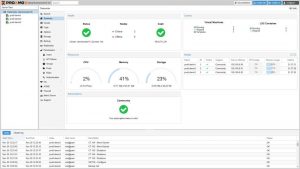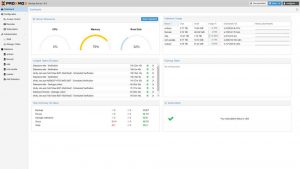Proxmox VE V6.3 Server Virtualization Management Platform With Backup Server Integration and Ceph Octopus
Based on Debian Buster 10.6, uses long-term support Linux kernel (5.4), and includes updates to latest versions of open-source technologies for virtual environments like QEMU 5.1, LXC 4.0, Ceph 15.2, and ZFS 0.85.
This is a Press Release edited by StorageNewsletter.com on December 2, 2020 at 1:57 pmProxmox Server Solutions GmbH released version 6.3 of its server virtualization management platform, Proxmox VE.
Click to enlarge
This version is based on Debian Buster 10.6, but uses the latest long-term support Linux kernel (5.4), and includes updates to the latest versions of open-source technologies for virtual environments like QEMU 5.1, LXC 4.0, Ceph 15.2, and ZFS 0.85.
Integration for Proxmox Backup Server
The most notable feature is the integration of the stable version 1.0 of Proxmox Backup Server, the company’s open-source, enterprise backup solution, for backing up and restoring VMs, containers, and physical hosts. The Backup Server supports incremental, fully deduplicated backups and facilitates strong encryption. The virtualization platform Proxmox VE is supported, allowing users to backup VMs and containers – even between remote locations. For VMs, it uses QEMU dirty-bitmaps, meaning backups from the Proxmox VE client to the firm’s Backup Server are fast, as only the changed data is transmitted.
Proxmox Backup Server 1.0 dashboard
Click to enlarge
In VE 6.3, users just need to add the Backup Server datastore as a new storage target. All client-to-server traffic can be encrypted on the client-side, to safeguard data before backing up to Backup Server. The backup client makes creating and managing encryption keys simple. The program offers multiple ways to store keys, so that they remain safe and can be obtained when needed: users can save key files to a secure file server or USB drive, copy the key as text into a password manager, or print the key on paper and, for example, store it in a safe.
Support for Ceph Octopus and Ceph Nautilus
VE 6.3 supports Ceph Octopus 15.2.6 and Ceph Nautilus 14.2.15. Users can select their preferred Ceph version during the installation process. Many Ceph-specific management features have been added to the VE dashboard during the Ceph Octopus development cycle, including the displaying of recovery progress in the Ceph status panel.
In this version, it’s now possible to view and set the placement groups (PGs) auto-scaling mode for each Ceph pool in the storage cluster. This brings a lot of flexibility to the Ceph storage cluster and reduces the maintenance effort. Ceph has been integrated in VE since 2014 with version 3.2, and thanks to the software’s user interface, installing and managing Ceph clusters is easy. Ceph Octopus now adds multi-site replication capabilities, that are important for large-scale redundancy and disaster recovery.
Enhanced Web interface
With the integrated, web-based user interface, VE makes configuring, managing, and monitoring the virtualized datacenter straightforward, and with V6.3 more functionality and usability enhancements have been added.
This includes:
-
Editing external metric servers: VE nodes can be connected to InfluxDB or Graphite via the GUI to facilitate monitoring.
-
Improved editor for VM boot order: It is possible to select multiple devices per type (disk, network) for booting. The user experience has been improved with drag-and-drop functionality.
-
Optional TLS certificate verification for LDAP and AD authentication realms.
-
Backup/restore: Users can get an overview of all guests, which aren’t included in any backup at any backup state. Also, a detailed view per backup job is available, showing all covered guests and the disks which are backed up.
-
Optional comments for all storage types can be displayed in the web interface. Additionally, the company’s Backup Server displays the verification state of all backed up snapshots.
Further enhancements:
-
Storage:
-
-
The backup retention settings allow users to adapt and control retention periods based on their business needs. For each storage or backup job, users can implement enhanced retention policies, and decide on how many backups to keep per time frame.
-
To monitor SSD wear leveling, querying has been improved.
-
-
-
Container: VE 6.3 supports systems up to 8,192 cores and supports Kali Linux and Devuan distribution containers, as well as the last versions of Ubuntu, Fedora and CentOS. In addition, features such as per-container timezone support and improved startup monitoring have been added.
-
Many improvements to user and permission management have been included, such as support for using client certificates/keys when connecting to AD/LDAP realms and support for optional case-insensitive logins with AD/LDAP realms.
-
General improvements for virtual guests include improved handling of replicated guests when migrating.
-
Firewall: Improved API and GUI for matching ICMP-types.
-
Installer: Reboot automatically upon successful installation.
Availability:
Proxmox VE 6.3 is available for download.
-
Distribution upgrades from some older versions of Proxmox VE are possible with apt. It’s also possible to install the V6.3 on top of Debian Buster.
-
Proxmox VE is published under the free software license GNU Affero GPL, v3. Enterprise support is available from Proxmox Server solutions on a subscription basis, starting at EUR 85 per year, per CPU. (information).
Facts:
The open-source project Proxmox VE has an user base with more than 390,000 hosts. The virtualization platform has been translated into over 26 languages. More than 55,000 active community members in the support forum engage with each other. By using it, as an alternative to proprietary virtualization management solutions, enterprises are able to centralize and modernize their IT infrastructure, and turn it into a cost-effective and flexible software-defined data center, based on the latest open-source technologies. Tens of thousands of customers from companies regardless of sector, size or industry rely on a support subscription, a service offered by the company.
About Proxmox VE
It is an open-source platform for all-inclusive enterprise virtualization. With the central web interface, you can run VMs and containers, manage software-defined storage and networking functionality, high-availability clustering, and multiple integrated out-of-the-box tools like backup/restore, live migration, replication, and the firewall. Enterprises use the powerful yet easy-to-manage, all-in-one solution, Proxmox VE, to meet the core requirements of modern data centers. It allows them to remain adaptable for future growth, thanks to its flexible, modular and open architecture.
About Proxmox Server Solutions
It is a provider of open-source server software. Enterprises, regardless of size, sector or industry use the stable, secure, and scalable firm’s solutions to deploy efficient, agile and simplified IT infrastructures, minimize total cost of ownership, and avoid vendor lock-in. It also offers commercial support and training to ensure business continuity for its customers. It was established in 2005 and is headquartered in Vienna, Austria.
















 Subscribe to our free daily newsletter
Subscribe to our free daily newsletter


